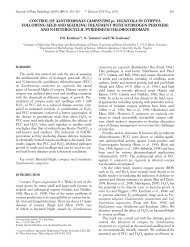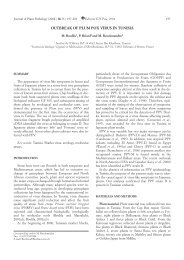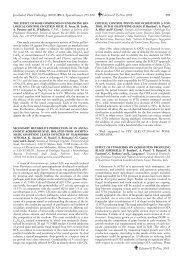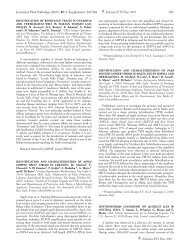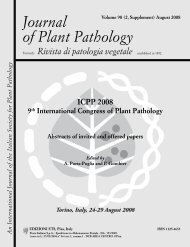Journal of Plant Pathology (2010), 92 (4, Supplement ... - Sipav.org
Journal of Plant Pathology (2010), 92 (4, Supplement ... - Sipav.org
Journal of Plant Pathology (2010), 92 (4, Supplement ... - Sipav.org
You also want an ePaper? Increase the reach of your titles
YUMPU automatically turns print PDFs into web optimized ePapers that Google loves.
<strong>Journal</strong> <strong>of</strong> <strong>Plant</strong> <strong>Pathology</strong> (<strong>2010</strong>), <strong>92</strong> (4, <strong>Supplement</strong>), S4.71-S4.105 S4.73<br />
During an extensive survey <strong>of</strong> clinically relevant Fusarium<br />
species (Migheli et al., <strong>2010</strong>, <strong>Journal</strong> <strong>of</strong> Clinical Microbiology 48:<br />
1076-1084), fifty-eight fusaria isolated in Northern and Central<br />
Italy from 50 Italian patients between 2004 and 2007 were subjected<br />
to multilocus DNA sequence typing to characterize the<br />
spectrum <strong>of</strong> species and circulating sequence types associated<br />
with dermatological infections, especially onychomycoses and<br />
paronychia, and other fusarioses. Sequence typing revealed that<br />
isolates were nearly evenly divided among the Fusarium solani<br />
(FSSC, N =18), the F. oxysporum (FOSC, N = 20) and the Gibberella<br />
(Fusarium) fujikuroi (GFSC, N = 20) species complexes.<br />
Among the GFSC, a two-locus typing scheme was used to successfully<br />
identify 17 isolates as F. verticillioides, two as F. sacchari<br />
and one as F. guttiforme (the latter from paronychia on a 65-yearold<br />
female in good health). Since the only known host for F. guttiforme<br />
is pineapple (Ananas comosus), we wanted to determine<br />
whether the patient had come in contact with fresh pineapple<br />
fruits possibly harbouring this pathogen and to further characterize<br />
this isolate to see if it was pathogenic to pineapple. A followup<br />
interview revealed that the patient frequently consumed fresh<br />
pineapple after peeling it by hand. Results <strong>of</strong> a pathogenicity experiment<br />
revealed that the human pathogenic F. guttiforme isolate<br />
NRRL 53131 was able to induce tissue necrosis and to sporulate<br />
pr<strong>of</strong>usely after 14 days incubation at 25°C when inoculated on<br />
artificially wounded pineapple leaves. The same symptoms were<br />
induced by the ex-holotype positive control strain <strong>of</strong> F. guttiforme<br />
(NRRL 25295).<br />
FLUORESCENT AFLP ANALYSIS OF ALTERNARIA AL-<br />
TERNATA ISOLATES CAUSING BROWN SPOT OF CIT-<br />
RUS. P. Bella 1 , G. Ialacci 1 , M. Russo 2 , A. Catara 1,2 , V. Catara 1 .<br />
1 Dipartimento di Scienze e Tecnologie Fitosanitarie, Università<br />
degli Studi, Via Santa S<strong>of</strong>ia 100, 95123 Catania, Italy. 2 Parco Scientifico<br />
e Tecnologico della Sicilia, Zona Industriale, Via V. Lancia,<br />
95030 Catania, Italy. E-mail: patrizia.bella@unict.it<br />
Alternaria brown spot, caused by the tangerine pathotype <strong>of</strong><br />
Alternaria alternata, seriously affects yield and fruit quality <strong>of</strong> citrus<br />
tangerines and their hybrids. After the first report in Italy in<br />
2000, the disease has become a real threat, especially for the more<br />
susceptible citrus cultivars, which require an adequate schedule<br />
<strong>of</strong> treatments. Since no information on the population structure<br />
<strong>of</strong> A. alternata in Italy is available, a collection <strong>of</strong> isolates already<br />
characterized by conidial morphology, pathogenicity tests and endoPG<br />
sequence analysis, was further compared by fluorescent<br />
amplified fragment length polymorphism analysis (fAFLP), in order<br />
to assess intra-population diversity. Pre-amp Primer Mix I<br />
(Invitrogen), containing adapter complementary AFLP<br />
primers for EcoRI and MseI sites, each with one selective nucleotide,<br />
was used in the pre-amplification reaction. To choose<br />
the most performing selective primer combination, selective amplification<br />
was preliminarily performed on few isolates using four<br />
different selective primer pairs, bearing at 3’ends two selective<br />
nucleotides. Three primer pairs were discarded since the number<br />
<strong>of</strong> picks they generated neither allowed a clear comparison <strong>of</strong> fingerprint<br />
patterns nor detected genetic variability. The primer<br />
combination, Ecosel2 (+GA)/Msesel(+CT), produced an adequate<br />
number <strong>of</strong> picks and was chosen for the analysis <strong>of</strong> the collection<br />
<strong>of</strong> A. alternata isolates. UPGMA-based cluster analysis<br />
from the similarity matrix obtained using Jaccard coefficient, revealed<br />
the presence <strong>of</strong> at least two sub-populations. Isolates obtained<br />
from different groves either clustered together or into two<br />
distinct clusters, regardless <strong>of</strong> the cultivar they came from.<br />
FIRST REPORT OF IMPATIENS NECROTIC SPOT VIRUS<br />
INFECTING ONCIDIUM IN ITALY. M.G. Bellardi 1 and C.<br />
Cavicchi 2 . 1 Dipartimento di Scienze e Tecnologie Agroambientali,<br />
Sezione di Patologia Vegetale, Università degli Studi, Viale Fanin<br />
42, 40127 Bologna, Italy. 2 Plesso Didattico G. Scarabelli, Università<br />
degli Studi di Bologna, Viale G. Ascari 15, 40026 Imola (BO),<br />
Italy. E-mail: mariagrazia.bellardi@unibo.it<br />
Oncidium is a large genus <strong>of</strong> orchids that includes over 600<br />
species. The quality <strong>of</strong> Ligurian Oncidium potted pants and cut<br />
flowers is highly appreciated in the Italian floral auction market,<br />
and the number <strong>of</strong> producers has increased in the Sanremo area<br />
in the last decade. During spring 2008, Impatiens necrotic spot<br />
virus (INSV) was found by DAS-ELISA in greenhouse-grown<br />
Oncidium orchids displaying leaf symptoms that ranged from<br />
necrotic concentric rings to necrotic lesions 1-2 cm in diameer.<br />
Subsequently, symptomatic leaves exhibited yellowing and necrosis<br />
along the veins but no flower symptoms. Oncidium plants<br />
were growing adjacent to Ranunculus hybrids infected by this<br />
tospovirus. To confirm the presence <strong>of</strong> INSV, total RNA was extracted<br />
from symptomatic Oncidium leaves and used for RT-PCR<br />
amplification <strong>of</strong> the nonstructural protein gene <strong>of</strong> INSV. The resulting<br />
primers directed the amplification <strong>of</strong> a PCR product <strong>of</strong><br />
approximately 1300 nt. To verify that the amplified products<br />
were derived from INSV RNA, the PCR fragment was cloned<br />
and two independent clones were sequenced in both directions.<br />
Sequence analyses <strong>of</strong> the cloned PCR product showed 98.6% nucleotide<br />
sequence identity, and 98.2 and 99.2% amino acid identity<br />
and similarity, respectively with a previously published INSV-<br />
NSs sequence (Gene Bank accession No. NC_003624). Methods<br />
for reducing the risk <strong>of</strong> this disease include the use <strong>of</strong> healthy<br />
plant material, removal <strong>of</strong> weeds acting as hosts for the insect<br />
vector (Frankliniella occidentalis) or the use <strong>of</strong> insecticides to prevent<br />
virus transmission. This is thought to be the first report <strong>of</strong><br />
INSV infecting Oncidium in Italy.<br />
STUDY OF TWO DIFFERENT HYDROPHOBINS IN<br />
GEOSMITHIA spp. P. Bettini 1 , L. Carresi 2 , C. Comparini 2 , G.<br />
Tomai 1 , R. Viganò 1 , L. Pazzagli 3 , A.L. Pepori 4 , A. Santini 4 , G.<br />
Cappugi 3 , F. Scala 5 , A. Scala 2 . 1 Dipartimento di Biologia<br />
Evoluzionistica “Leo Pardi”, Università degli Studi, Via Romana<br />
17, 50125 Firenze, Italy. 2 Dipartimento di Biotecnologie Agrarie,<br />
Sezione di Protezione delle Piante, Università degli Studi, Via della<br />
Lastruccia 10, 50019 Sesto Fiorentino (FI), Italy. 3 Dipartimento di<br />
Scienze Biochimiche, Università degli Studi, Firenze, Italy. 4 Istituto<br />
per la Protezione delle Piante del CNR. Via Madonna del Piano 10,<br />
50019 Sesto Fiorentino (FI), Italy. 5 Dipartimento di Arboricoltura,<br />
Botanica e Patologia Vegetale, Università degli Studi “Federico II”,<br />
Via Università 100, 80055 Portici (NA), Italy. E-mail:<br />
aniello.scala@unifi.it<br />
The genus Geosmithia includes several fungal species associated<br />
with phloem-feeding bark beetles. In previous studies, we<br />
showed that the gene encoding cerato-ulmin (cu) in Ophiostoma<br />
novo-ulmi was also present in a Geosmithia isolate obtained from<br />
an elm tree affected by Dutch Elm Disease (DED). To explain<br />
this result, we hypothesized a horizontal gene transfer (HGT).<br />
Thirty-six isolates <strong>of</strong> Geosmithia, collected from elm trees with<br />
DED symptoms, were used in this work to verify if other Geosmithiae<br />
contained the cu gene. Sequencing <strong>of</strong> the PCR products<br />
obtained with different primer pairs designed on the cu gene sequence<br />
revealed that fragments highly homologous to the cu gene<br />
were present in all the analyzed Geosmithia isolates. Culture filtrates<br />
<strong>of</strong> 16 Geosmithia isolates gave a positive response in ELISA<br />
assays using anti-CU antibodies; however, Western blotting and



